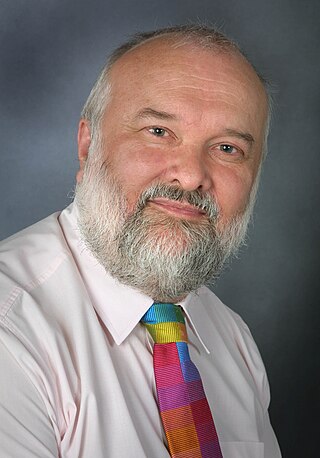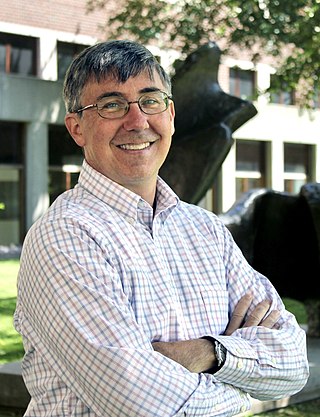Related Research Articles
Antigenic drift is a kind of genetic variation in viruses, arising from the accumulation of mutations in the virus genes that code for virus-surface proteins that host antibodies recognize. This results in a new strain of virus particles that is not effectively inhibited by the antibodies that prevented infection by previous strains. This makes it easier for the changed virus to spread throughout a partially immune population. Antigenic drift occurs in both influenza A and influenza B viruses.
Global optimization is a branch of applied mathematics and numerical analysis that attempts to find the global minima or maxima of a function or a set of functions on a given set. It is usually described as a minimization problem because the maximization of the real-valued function is equivalent to the minimization of the function .
Virus-like particles (VLPs) are molecules that closely resemble viruses, but are non-infectious because they contain no viral genetic material. They can be naturally occurring or synthesized through the individual expression of viral structural proteins, which can then self assemble into the virus-like structure. Combinations of structural capsid proteins from different viruses can be used to create recombinant VLPs. Both in-vivo assembly and in-vitro assembly have been successfully shown to form virus-like particles. VLPs derived from the Hepatitis B virus (HBV) and composed of the small HBV derived surface antigen (HBsAg) were described in 1968 from patient sera. VLPs have been produced from components of a wide variety of virus families including Parvoviridae, Retroviridae, Flaviviridae, Paramyxoviridae and bacteriophages. VLPs can be produced in multiple cell culture systems including bacteria, mammalian cell lines, insect cell lines, yeast and plant cells.

Influenza B virus is the only species in the genus Betainfluenzavirus in the virus family Orthomyxoviridae.

Henry Stephen Rzepa is a chemist and Emeritus Professor of Computational chemistry at Imperial College London.
Aluminium phosphate is a chemical compound. In nature it occurs as the mineral berlinite. Many synthetic forms of aluminium phosphate are known. They have framework structures similar to zeolites and some are used as catalysts, ion-exchangers or molecular sieves. Commercial aluminium phosphate gel is available.

Nicholas (Nikolaos) A. Peppas is a chemical and biomedical engineer whose leadership in biomaterials science and engineering, drug delivery, bionanotechnology, pharmaceutical sciences, chemical and polymer engineering has provided seminal foundations based on the physics and mathematical theories of nanoscale, macromolecular processes and drug/protein transport and has led to numerous biomedical products or devices.

Hypothetical zeolites are combinatorial models of potential structures of the minerals known as zeolites. They are four-regular periodic graphs, with vertices representing the tetrahedral atom and the edges representing the bridging oxygen atoms. Alternatively, by ignoring the tetrahedral atoms, zeolites can be represented by a six-valent periodic graph of oxygen atoms, with each O-O edge defining an edge of a tetrahedron.

Sharon C. Glotzer is an American scientist and "digital alchemist", the Anthony C. Lembke Department Chair of Chemical Engineering, the John Werner Cahn Distinguished University Professor of Engineering and the Stuart W. Churchill Collegiate Professor of Chemical Engineering at the University of Michigan, where she is also professor of materials science and engineering, professor of physics, professor of macromolecular science and engineering, and professor of applied physics. She is recognized for her contributions to the fields of soft matter and computational science, most notably on problems in assembly science and engineering, nanoscience, and the glass transition, for which the elucidation of the nature of dynamical heterogeneity in glassy liquids is of particular significance. She is a member of the National Academy of Sciences, the National Academy of Engineering, and the American Academy of Arts and Sciences.
Massively Parallel Monte Carlo (MPMC) is a Monte Carlo method package primarily designed to simulate liquids, molecular interfaces, and functionalized nanoscale materials. It was developed originally by Jon Belof and is now maintained by a group of researchers in the Department of Chemistry and SMMARTT Materials Research Center at the University of South Florida. MPMC has been applied to the scientific research challenges of nanomaterials for clean energy, carbon sequestration, and molecular detection. Developed to run efficiently on the most powerful supercomputing platforms, MPMC can scale to extremely large numbers of CPUs or GPUs. Since 2012, MPMC has been released as an open-source software project under the GNU General Public License (GPL) version 3, and the repository is hosted on GitHub.

John Francis Brady is an American chemical engineer and the Chevron Professor of Chemical Engineering and Mechanical Engineering at the California Institute of Technology. He is a fluid mechanician and creator of the Stokesian dynamics method for simulating suspensions of spheres and ellipsoids in low Reynolds number flows. He is an elected fellow of the American Physical Society, a fellow of the Society of Rheology, as well as a member of the National Academy of Sciences, the National Academy of Engineering, and the American Academy of Arts and Sciences.

Biman Bagchi is an Indian scientist currently serving as a SERB-DST National Science Chair Professor and Honorary Professor at the Solid State and Structural Chemistry Unit of the Indian Institute of Science. He is a theoretical physical chemist and biophysicist known for his research in the area of statistical mechanics; particularly in the study of phase transition and nucleation, solvation dynamics, mode-coupling theory of electrolyte transport, dynamics of biological macromolecules, protein folding, enzyme kinetics, supercooled liquids and protein hydration layer. He is an elected fellow of the Indian National Science Academy, the Indian Academy of Sciences, The World Academy of Sciences and an International honorary member of the American Academy of Arts and Sciences. Along with several scientific articles, he has authored three books, (i) Molecular Relaxation in Liquids, (ii) Water in Biological and Chemical Processes: From Structure and Dynamics to Function, and (iii) Statistical Mechanics for Chemistry and Materials Science.
Klavs Flemming Jensen is a chemical engineer who is currently the Warren K. Lewis Professor at the Massachusetts Institute of Technology (MIT).
Michael Tsapatsis is an American chemical engineer and materials scientist. Tsapatsis is the 36th Bloomberg Distinguished Professor at Johns Hopkins University in the Department of Chemical and Biomolecular Engineering. Prior to this position he was the Amundson Chair (2008–present), professor (2003-present), and McKnight Presidential Endowed Chair (2017–present) in the department of chemical engineering and Materials Science at the University of Minnesota. Prior to his appointment at the University of Minnesota, Tsapatsis was an associate professor at the University of Massachusetts Amherst.
Frank Steven Bates is an American chemical engineer and materials scientist. Bates is a Regent's Professor (2007–present), a Distinguished McKnight University Professor (1996–present), and department head (1999-2014) in the department of chemical engineering and materials science at the University of Minnesota, where he has been a faculty member since 1989. Prior to his appointment at the University of Minnesota, Bates was a member of the technical staff at AT&T Bell Laboratories from 1982-1989.
Raymond John Gorte is an American chemical engineer, currently the Russel Pearce and Elizabeth Crimian Heuer Endowed Professor of Chemical and Biomolecular Engineering (CBE) and Materials Science & Engineering (MSE) at the University of Pennsylvania. Throughout his career at the University of Pennsylvania and the University of Minnesota, he has advanced the study of fuel cells and catalysts including heterogeneous metals and zeolite materials. He is a member of the U.S. National Academy of Engineering.
Dionisios G. Vlachos is an American chemical engineer, the Allan & Myra Ferguson Endowed Chair Professor of Chemical Engineering at the University of Delaware and director of the Catalysis Center for Energy Innovation, a U.S. Department of Energy - Energy Frontiers Research Center. Throughout his career at University of Delaware and the University of Minnesota, he has advanced the study of catalysts and reaction engineering including catalytic applications in biomass utilization, alkane conversion and zeolites. He is a fellow of the American Association for the Advancement of Science and recipient of the Wilhelm Award of the American Institute of Chemical Engineers (2011).

Jörg Kärger is a German physicist.

William H. Green Jr., is a Hoyt C. Hottel Professor of Chemical Engineering at the Massachusetts Institute of Technology, working in the field of chemical reaction engineering.
Ronald G. Larson is George G. Brown Professor of Chemical Engineering and Alfred H. White Distinguished University Professor at the University of Michigan, where he holds joint appointments in macromolecular science and engineering, biomedical engineering, and mechanical engineering. He is internationally recognized for his research contributions to the fields of polymer physics and complex fluid rheology, especially in the development of theory and computational simulations. Notably, Larson and collaborators discovered new types of viscoelastic instabilities for polymer molecules and developed predictive theories for their flow behavior. He has written numerous scientific papers and two books on these subjects, including a 1998 textbook, “The Structure and Rheology of Complex Fluids”.
References
- ↑ "Home". mwdeem.org.
- ↑ Earl, David J.; Deem, Michael W. (2004). "Evolvability is a selectable trait" (PDF). Proceedings of the National Academy of Sciences USA. 101 (32): 11531–6. arXiv: q-bio/0407012 . Bibcode:2004PNAS..10111531E. doi: 10.1073/pnas.0404656101 . PMC 511006 . PMID 15289608.
- ↑ Gupta, V; Earl, David J.; Deem, Michael W. (2006). "Quantifying influenza vaccine efficacy and antigenic distance". Vaccine. 24 (18): 3881–8. doi:10.1016/j.vaccine.2006.01.010. PMC 4474378 . PMID 16460844.
- ↑ Earl, David J.; Deem, Michael W. (2005). "Parallel tempering: Theory, applications, and new perspectives". Physical Chemistry Chemical Physics. 7 (23): 3910–6. arXiv: physics/0508111 . Bibcode:2005PCCP....7.3910E. doi:10.1039/B509983H. PMID 19810318. S2CID 14009137.
- ↑ Pophale, R.; Cheeseman, PA; Deem, MW (2011). "A database of new zeolite-like materials". Physical Chemistry Chemical Physics. 13 (27): 12407–12. Bibcode:2011PCCP...1312407P. doi:10.1039/c0cp02255a. PMID 21423937.